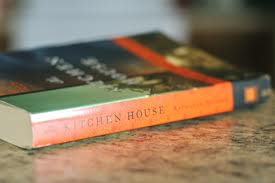21 Mar Page turning tension in the Kitchen House
As I continue to make my way through this month’s novel, The Kitchen House by Canadian-born, Kathleen Grissom, I look forward to blogging about this book. I’m finding it to be a wonderful read, full of page-turning tension, tenderly explored characters, and tragic circumstances.
Racial injustice and cruelty abound; there’s plenty of death (by accident, yellow fever, unknown illness or murderous dealings), addiction, even deeply disturbing hints of pedophilia, but Grissom deals with the darkness of the day with a light but believable hand. Not dwelling on details but adeptly blending such events into the daily lives of both blacks and whites, right from the start it’s clear the author intends to tell her tale without feigned sympathy, but clear compassion and sincerity, fairness to all sides, and a yearning for the mending of racial divide.
Readers can’t help but cheer for kind and dignified characters like, Ma and Pa, the parental figures of the kitchen house. Despite their indenture, they work tirelessly to straddle the blurry line between loyalty to their families and the suffering blacks of the quarters, and their devotion to their jobs as servants to the honorable captain and his opium-addicted wife. Knowing their station in life is good for a coloured person, their master a decent, honest, and ultimately kind man who treats his slaves with as much decency as the day can afford, they conduct themselves with intelligence, humor, and wisdom, ever fighting to keep everyone safe and all together. They do not judge a person because of skin colour, even taking in Lavinia as a daughter.
So many characters, so many constant events, I could go on about each. The captain’s compassion arises from having fallen in love in love with a black woman (who dies and for whom the captain grieved as though she were white). Belle (now an employee of the kitchen house) is the beautiful and feisty daughter of that passionate union who struggles to make peace with her awkward position as the half black/half white daughter of the captain. Of course, at the time, it was illegal for blacks and whites to marry and after his true love’s death, the captain goes on to marry Miss Martha, with whom he has two children at the beginning of the book and a third later on.
Miss Martha, raised in Philadelphia, yearns for the city and her own sister, and after suffering great tragedy, begins to confide in Lavinia, taking comfort in a fellow white person, whom she teaches to read. Not unlike her husband in terms of her innate kindness toward all people, Miss Martha suffers from depression, a respect for but mistrust of blacks, terrible grief (can’t say exactly what as it would spoil the read) and general lack of fortitude that has her turning to the black drops for comfort.
I’m anxious to see what become of the captain and Martha’s son, Master Marshall; an interesting character who deeply loves his little sister, Sally, but struggles from fits of rage due to the abuse he suffers at the hands of his horrific tutor, the despicable Mr. Waters. While not described in detail the suggestion of these scenes is gut-wrenching. At the 1/3 point, Marshall has been sent away to school and it remains to be seen if his innate desire for justice and decency will overcome his horrific experiences with and lessons taught by abusive white men–not only Waters but the equally despicable Rankin, bigoted, cheating, lying, stealing boss of the slave quarters and plantation fields.
Ultimately this book is about family–of all kinds–and the power of love and loyalty. Dedicated to her “beloved parents” and her “dear mentor”, it seems Ms. Grissom’s book itself comes from a place of powerful love.
See you on Free-For-All-Friday.
Cheers!
Shannon


